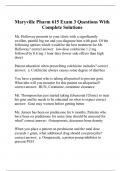Resume
Summary organisational theory and design (Steffi Weil) - UA 2024
- Établissement
- Universiteit Antwerpen (UA)
This is a summary of all lessons, required literature and guest lectures of the subject Organisational Theory and Design taught by Steffi Weil at the University of Antwerp.
[Montrer plus]












